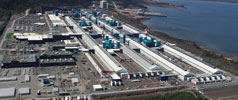OSIsoft helps facilitate aluminium smelter upgrade
May 2010
IT in Manufacturing

“A 1,4 billion (Canadian dollar) project to increase the production capacity of the Aluminerie Alouette plant called for the plant’s automation technology
to be replaced. The challenge was to maintain all production controls while replacing and substantially increasing data processing capabilities. Thanks to the PI System provided by OSIsoft, we met this challenge without adversely affecting production. We maintained the capacity for processing a data stream of 70 000 items per second in real-time!” says Robert Pelletier, computer specialist, Automation & Production Systems, Aluminerie Alouette.
Ability to sustain 24/7 plant operation during upgrade
Since Alouette’s plant is running 24/7, it was (and is) essential that the process managing systems never stop. It is one of the elements of the OSIsoft vision that enormously appealed to Alouette’s executives.
Within the context of the plant expansion, Alouette’s automation and production systems department required a robust, dependable system capable of processing more than 70 000 data items per second.
Furthermore, the system had to be easy to install and capable of handling the company’s future needs. “Because our system runs non-stop, and must be capable of meeting our needs one, two, or three years down the road,” observed the manager, automation and production systems.
One of the most important criteria proposed by SNCLavalin Hatch officials was selecting a tool that was already well established worldwide. The PI System has been around for decades, and is used throughout the world.
Installing the PI system whilst maintaining production
From the outset, the automation and production systems team at Aluminerie Alouette had to process data that was output from the old databases (scada interface running VXL on VMS Alpha) in tandem with the new PI System to ensure continuity of production. At the same time, it integrated data from the new equipment, as it gradually came on line. The processing had to occur without production managers noticing changes.
“Installing the PI System went very smoothly,” says Pelletier. “We set up a temporary interface between the old systems and the new PI System. As the new systems were phased in, we redirected the data sources without any impact on production. This was clearly the stage at which problems were likely to arise. Even though everything did not work as expected right off the bat, on the whole, installation went smoothly and no data was lost.”
The PI system in operation
Today, all production data at the Aluminerie Alouette plant is integrated and processed by the PI System. The operating network includes:
* Four PI servers of 20 000 tags each.
* Seven data acquisition nodes.
* Data collection interfaces used: OPC, CSV file loader and MCN Health Monitor.
Readers wanting to find out more about this application can view the full article at http://instrumentation.co.za/+c13809a
For more information contact Nick Stead, OSIsoft, +27 (0)31 767 2111, [email protected], www.osisoft.com
Further reading:
Unlocking mining efficiency with advanced processing control
IT in Manufacturing
ABB’s Advanced Process Control system, powered by its Expert Optimizer platform, is emerging as a key enabler of smarter, more efficient mining operations.
Read more...
PC-based control regulates innovative dehumidifiers
Beckhoff Automation
IT in Manufacturing
The Swedish company Airwatergreen AB is breaking new ground in the dehumidification of air in industrial buildings and warehouses. PC-based control from Beckhoff regulates the innovative process.
Read more...
Harnessing AI and satellite imagery to estimate water levels in dams
IT in Manufacturing
Farmers and water managers often struggle to accurately estimate and monitor the available water in dams. To address the challenge, International Water Management Institute researchers have worked with Digital Earth Africa to create an innovation that uses satellite images and AI to get timely and accurate dam volume measurements.
Read more...
Why industry should enter the world of operator training simulators
Schneider Electric South Africa
IT in Manufacturing
System-agnostic operator training simulator (OTS) software is a somewhat unsung hero of industry that trains plant operators in a virtual world that mirrors real-world operations. The benefits are multiple.
Read more...
Track busway for scalable data centre power delivery
IT in Manufacturing
The latest generation Legrand Data Centre Track Busway technology addresses the operational pressures facing today’s high-density, AI-intensive computing environments and is being well received by data centre facilities around the world.
Read more...
Poor heat management in data centre design
IT in Manufacturing
Designing a world-class data centre goes beyond simply keeping servers on during load shedding; it is about ensuring they run efficiently, reliably, and within the precise environmental conditions they were built and designed for.
Read more...
It’s time to fight AI with AI in the battle for cyber resilience
IT in Manufacturing
Cybercrime is evolving rapidly, and the nature of cyber threats has shifted dramatically. Attacks are now increasingly powered by AI, accelerating their speed, scale and sophistication. Cybersecurity needs to become part of business-critical strategy, powered by AI to match attackers’ speed with smarter, faster and more adaptive defences.
Read more...
Why AI sustainability must be a boardroom priority
IT in Manufacturing
As South African companies race to harness artificial intelligence for innovation and growth, few are asking the most critical question - the environmental cost.
Read more...
RS South Africa shines spotlight on MRO procurement
RS South Africa
IT in Manufacturing
RS South Africa has highlighted the growing pressures faced by procurement professionals responsible for maintenance, repair and operations supplies across the country’s vital economic sectors.
Read more...
Sustainable energy management
Siemens South Africa
IT in Manufacturing
Utilising its innovative ONE approach technology, Siemens provides complete transparency on resource consumption and offers data-driven optimisation recommendations for sustainable energy management.
Read more...


